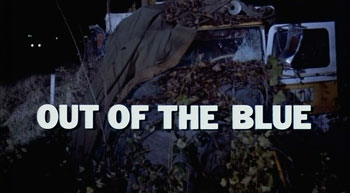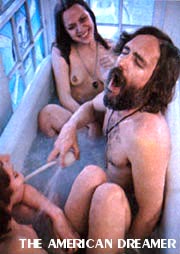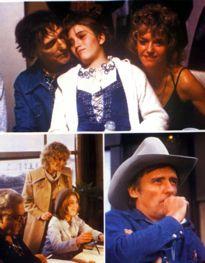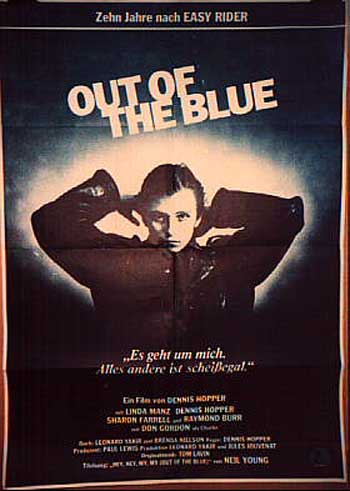| Films
You May Have Missed
by Alfred Chamberlain

Hey there,
kids! The first film we’d like to share remains one
of the least seen masterpieces we know of. Equal parts punk
atom bomb & Cashiers du Cinema burnout, Dennis
Hopper’s Out of the Blue is quite unlike
anything you’ve ever seen. “Oh, him”
yr prolly burping right about now. But trust us men, one glance
at Hopper’s filmography will leave you wandering just
what the hell you were thinking. Despite tremendous gaps where
the man’s career was deader than black death, the goddamned
thing is chock full of some of the finest celluloid in history.
He’d been
a promising youngster alongside James Dean & Natalie Wood
& Nicholas Ray in some sort of U.S. pre-new-wave in the
mid-50s. After his close friend Dean fed the Beyond’s
insatiable appetite for hip souls, Hopper tried to fill the
void w/his own ego. On the set of ‘58’s From
Hell to Texas, Hopper, then 22, disregarded 30-year
veteran director Henry Hathaway’s instructions for a
scene. The stubborn Hopper refused to alter his original take—the
take he wanted to use—aping it eighty-plus
times over ensuing days, infuriating everyone & earning
a rep w/in the studio system that destroyed his burgeoning
career for more than ten years.
Tho
he claims he turned down the lead in the Splendor
in the Grass, Hopper was ignored by Hollywood thru
a decade of TV and B-film work. After learning the ropes like
so many of his contemporaries under B-film kingpin Roger Corman,
Hopper directed his unknown pals Jack Nicholson, Peter Fonda,
& Karen Black in 1969’s small-budget Easy
Rider. His directorial debut changed the landscape
of American cinema. It revolutionized everything from the
soundtrack (it was the first American film to use “found
music”—music not specifically composed for the
film) to the way studios viewed the risen American youth/insurgency.
Hollywood finally found something that the hip would buy from
them.
Hopper
and friends became household names & the studios came
calling. His directorial follow-up, ‘71’s The
Last Movie, would push his success to the END. Shot
in Peru w/actor & musician friends (especially dig Sam
Fuller making one of his infamous cameos), The Last
Movie is a sprawling, broken masterpiece that eats
itself raw, spewing endless ideas, improvisations, and you-are-watching-a-film
fuckery. Walled up w/the footage back at his compound in New
Mexico (& zonked out of his mind from every drug on the
table), Hopper panicked during the editing process, supposedly
calling in Alejandro Jodorowsky for help (yip!). The film
is surely the most radical & fucked expression ever produced
by a Hollywood  studio—and
an absolute nuclear bomb “at” the box office.
Universal was dumbfounded at the final product & w/zero
distribution since its limited release, one of the penultimate
expressions of the period remains widely unknown & unseen.
(For more on this period, dig a bootleg of American
Dreamer, a documentary about the editing of The
Last Movie, featuring naked groupies, naked Hopper,
and naked ego.) studio—and
an absolute nuclear bomb “at” the box office.
Universal was dumbfounded at the final product & w/zero
distribution since its limited release, one of the penultimate
expressions of the period remains widely unknown & unseen.
(For more on this period, dig a bootleg of American
Dreamer, a documentary about the editing of The
Last Movie, featuring naked groupies, naked Hopper,
and naked ego.)
Hopper
was a Hollywood zero following this second unforgivable sin
& would be seen almost exclusively in foreign-made films
for another ten years, save for kingpin Coppola’s offbeat
castings. In 1980, between his resurrecting turns in Apocalypse
Now & Rumble Fish, Hopper took
a co-starring role in a tiny family trauma-drama called Cebe,
to be shot in Vancouver. The executive producer of the film
was Hopper’s longtime friend Paul Lewis, production
manager on Easy Rider & producer of The
Last Movie. Hopper was to play the father of Cebe
(Linda Manz) in a true story about a young girl who had killed
her father & a few others & was then rescued back
from the damned by a shrink, the film’s star, narrator,
& Canadian, TV’s Ironside &
Perry Mason, Raymond fucking Burr.
During
the first week of shooting by writer & first-time director
Leonard Yakir, hip Hopper bonds w/hip Manz. Manz, just barely
18, had co-starred in reclusive genius Terrence Malick’s
masterpiece Days of Heaven a couple years
earlier. A stumpy, scarred, & beautiful feminine oddity,
Manz is a sub-cult fave of the cineaste. Not much is known
about her early life except that it was horrendously rough,
a misfortune that seems to come across in her roles. Hopper,
then in his 40s, probably realizing that he’s working
a particularly shit job, spends much of his down time hanging
out w/Manz, picking up on her zeal for punk & playing
drums.
Eight
days into production, producer Lewis realizes that the footage
shot so far is completely unusable. W/just over five weeks
left of the six & a half week schedule, he gambles &
makes a change. Hopper agrees to step in as the new director
& promises to bring the film in before the deadline—a
notion that probably seemed ridiculous to anyone who’d
seen The Last Movie. He rewrites the entire
story during a short weekend, making Manz’s Cebe the
focal point of the film & all but removes Burr’s
shrink. He asks his friend Neil Young for a couple songs off
his latest record; "My My, Hey Hey (Out of the Blue)"
& "Thrasher" would be masterfully woven into
the third film that Dennis Hopper was allowed to direct, the
freshly christened Out of the Blue.
Manz is given
free reign to explore the new Cebe, a punk-loving vitriolic
15yr old drummer-wannabe whose drunk, big-rig driving father
Don (Hopper) returns from a 5yr prison stint for no-shit killing
a busload of smalltown USA’s children. The unruly, confident,
& staunchly tomboyish Cebe constantly laments the death
of Elvis, Sid Vicious, & Johnny Rotten (who was thankfully
still alive at the time & unfortunately remains so). Her
father’s imprint has left Cebe hanging in the balance,
oscillating between a childish thumb-sucking ballerina &
pure punk nihilism. Manz—who admitted to Hopper that
she did still suck her thumb at 18—pantomimes her way
to an extended, uncompromising fuckyou.

Manz’s stunning presence does not go unmatched. Cebe’s
Mom Kathy (a spot-on Sharon Farrell) is an adulterous junkie
third-wheel that completes the dysfunctional triangulation.
Don Gordon, Hopper’s old friend & intensely wild
co-star in The Last Movie, was sent for in
one of the new director’s first moves. Gordon, best
known perhaps for being Steve McQueen’s best friend,
disturbs as Hopper’s longtime cohort/instigator Charlie.
Man, if there’s ever been an actor that seems to be
more out of control than Hopper, it’s Gordon.
&
of course, Hopper lets a lot of reality into his role as the
alcoholic kid-slaughterer whose every moment is haunted. Admittedly
channeling the emotions that overwhelmed him from being behind
the camera again after so many years, Hopper is spellbinding
in scene after scene. Walking the invisible tight rope slowly,
as the man said, between pure naked tenderness & raging
drunken violence, it is gut-wrenching to take in his post-prison
existence working heavy equipment at a landfill & trying
to approximate his previous life at home. His welcome-home
party—which opens w/one of the films many hypnotic,
lengthy tracking shots—& the filming of the seagulls
at the landfill are surely some of the most remarkable scenes
of the period.
Raymond Burr’s
contract had to be satisfied by the filmmakers because of
Canadian tax-shelter laws requiring x-amount of Canadians
be used in the film. Burr clearly would have left the film
if he was aware his parts had largely been written out, so
he was never apprised of the new script. Instead, for seven
precious days Hopper takes the lump thru all of his initially
planned scenes, even giving in to the clueless Burr’s
demands that he not only be allowed to write his own scenes,
but read them from fucking cue-cards... It must have been
quite a pleasant feeling for all those in-the-know that Burr
would be relegated to a few precious minutes of actual screen-time.
& in those scenes, Hopper turned Manz loose on the unsuspecting
Burr. His confused horror watching Manz improvise w/a fan
for a few seconds is quite tasty. Legend holds that Burr didn’t
know he wasn’t the film’s star until he saw it
well after post-production, perhaps at the Cannes screening.
There are
a number of street scenes where passersby & pedestrians
are unknowingly cast into the film, sucked into Manz’s
orbit. Even those who were hired—all the kids, the mom’s
boyfriend, the AMAzing street performers, Vancouver punks
The Pointed Sticks & their fans, & everyone else other
than the four main characters—were non-actors, amplifying
Hopper’s love of neo-realism, Truffaut, & freedom.
It’s the element that allowed Hopper, like Allen Ginsberg,
like Bob Dylan, to stay perfectly relevant & THERE despite
the dramatic shifts in culture & subculture that’d
take place during their lengthy careers. Freedom.
It’s what makes Out of the Blue the
missing link between Jules Dassin & Harmony Korine. It’s
what makes every frame of this tightly-budgeted little wonder
ooze w/the color & imagination & humanity that we
should be running towards, & it’s out there waiting
for you right now. Go cut yrself a slice, brothers.
What happened to
our heroes? Hopper would work well w/the eighties: Rumble
Fish, Hoosiers, River’s
Edge, Robert Altman’s O.C. & Stiggs
(which is...well, we’ll try & deal w/the piece in
a future spiel), & most memorably in David Lynch’s
Blue Velvet. He has been allowed to direct
four more films, but hasn’t reached his previous heights
in that respect. If you must, dig the dated but cool Colors
& The Hot Spot, the best thing Don Johnson
has done other than A Boy and His Dog.
Perhaps we
could toss Manz into the “genius actresses of the 70s
who were canned by whitey in the 80s” bin (Ellen Burstyn
being the finest example). But more likely, Manz probably
retreated into family life, hopefully healing the wounds of
her youth. By all reports, she lives on a farm in the valley
w/five kids. She did, however, resurface in Harmony Korine’s
1997 freedomfest Gummo as Solly’s mom.
It was her first role in a dozen or more years & she’s
worked little since. The cracked staff over at Vice
magazine recently reported that Manz sold her killer Elvis
blue-jean jacket, donned throughout Out of the Blue,
to Gummo co-star Chloe Sevigny.
Raymond Burr
would later renounce his Canadian citizenship.
Be free,
Alfred C.

(A word
to the wise: an Out of the Blue DVD is currently
available on the Passion Productions imprint & it ain’t
such a hot product, tho it’s a worthy print & very
inexpensive. It’s the one Netflix has. For those with
more patience & budget, dig the earlier Anchor Bay DVD
edition, which has a superior print, commentary w/Hop, &
other shit.)
Alfred
Chamberlain is a contributor to Smallflowers
Press.

|